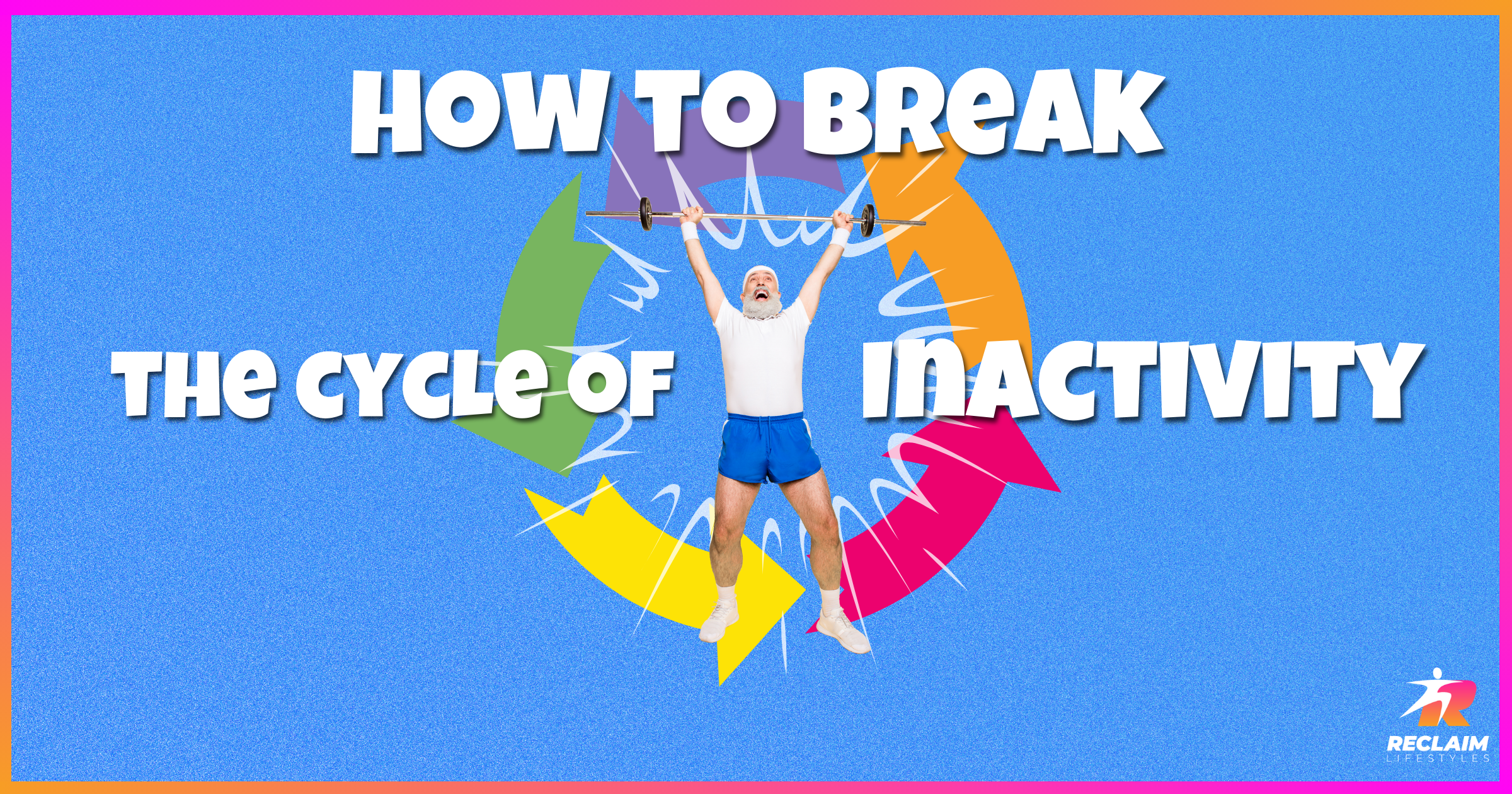How to Break the Cycle of Inactivity
Getting started is the hardest part of any new habit. That’s why there are so many books about how to change your life with healthier routines. Atomic Habits, The Power of Habit, The 7 Habits of Highly Effective People, the list goes on. And these are all, by the way, great books if you haven’t checked them out yet! And they exist precisely because so many of us struggle to do the things we know we ought to be doing to live our best, healthiest lives.
Newton’s laws of motion aren’t just about objects—a person in motion is likelier to stay in motion until a force acts upon them, and vice versa. So if you currently identify more with “an object at rest,” you may already intimately know how breaking through inertia takes a tremendous amount of force. Force that so many of us haven’t quite figured out how to muster.
In our last blog, we talked about the benefits of physical activity and the dangers of inactivity (read it here if you missed it). We have a lot of information to stoke our logical reasoning for why we should get active. However, as much as we’d like to think we are logical thinking beings, logic is rarely enough to get the ball rolling. How we feel guides our actions way more often than we may even be aware of.
Acknowledge the Challenge
When we tell ourselves it “should be easy” to implement XYZ new healthy habit, we tee up our inner critic with some real choice insults if we falter in the early stages. “How do you think you’re going to get any healthier? You can’t even do this one simple thing! You’ll never have enough willpower! Might as well give up now, loser,” it might taunt. But if there’s one thing we learned from our friend Neil’s incredible journey to start a running habit that led to him losing 110+ pounds, you have to anticipate this voice and decide that you are not going to listen to it, no matter how convincing it may sound. And you can help yourself out from the get-go by acknowledging that you are attempting to do something hard. Then, if you miss a day or can’t complete as much of a workout as you’d planned on, instead of beating yourself up, you can say to yourself, “Hey, I’m doing something really hard. It’s not going to be perfect. The best thing I can do now is just try again.”
Another part of acknowledging the challenge is breaking it down into smaller challenges. Rather than making a big, lofty goal like losing 50 pounds by bikini season, or running a marathon on your next birthday four months from now, focus on goals you can set and achieve with much shorter time horizons: working out three times a week for four weeks, for example. Setting goals that are centered around building a consistent habit will serve you much better in the long run than results-oriented goals. And as exhibited by our friend Neil, simply committing to consistency will probably lead to incredible results, some of which you may not have even been able to imagine while setting your goals.
Consistency-focused goals rather than results-oriented goals are great for the procrastinators among us. If your goal is to lose 50 pounds by summertime and you’re a person who tends to procrastinate, how likely do you think it is that you will start taking consistent steps toward that goal six months before June? Or might you wait until April and then panic, go on a crash diet, and start a wildly ambitious workout routine in an attempt to lose all 50 pounds in less than 60 days?
Versus: on January 1st, you set a goal to consistently workout three times a week for four weeks. Maybe the first week you only get two in, but that’s okay: you know that what you’re doing is difficult. You’re ironing out the kinks and working on your plan to reach your goal. By the beginning of February, you’ve done it. You’ve had four consecutive weeks of three workouts per week. So maybe now you add a day: four workouts per week for six weeks. In March, you feel stronger, lighter, and you’re ready to add another day, or now you notice that sodas are making you really sluggish for your workouts and decide to cut them out for a month. By the end of April, you are a person who works out four days a week and doesn’t drink soda.
Now you step on the scale and wow! Maybe you’re down 5 pounds, maybe 15, but what matters more than what’s on the scale is how good you feel about yourself and what you’ve accomplished, because you have set and achieved three or four goals now, and all of the corresponding activities that go along with those goals will undoubtedly have made you feel better physically as well. You’ve proven to yourself that you are capable of hard things, and you’ll take on the next challenge with even more confidence in your ability to keep trying, even if you’re not perfect in the process. Sounds like a better plan than the panic-diet/unsustainable-workout-binge one, right?
Make It Work for You
Beyond making goals that are focused on consistency rather than results, you can also give yourself permission to make your workouts look however you need them to look. Hate gyms? Don’t join one you’re not going to go to! Need the accountability of a class you’ve paid for to make sure you do something? Sign up for your favorite classes! Don’t want to buy anything? Use the resources you already have access to: the Internet, your phone, YouTube videos, etc. Look up bodyweight-only exercises (or better yet, download the Restart! app, which uses exclusively bodyweight-only exercises in its exercise library to build custom workouts for you based on your in-app feedback).
One of the messages we at Reclaim Lifestyles feel particularly passionate about getting out there is that working out does not have to be a whole production. It doesn’t have to look a particular way or be in a certain place to count. Any activity is better than no activity, so if your preferred way to workout is at 11pm at night after the kids are in bed, wearing pajamas in a corner of the basement and doing a yoga video on your laptop where no one can see you, have at it! If you want to get started with a running habit, you absolutely could go out and buy fancy new running shoes (maybe a new purchase will help you get excited about your new habit), but you also don’t have to wait until you have time for that errand. You can put on any old sneakers and just go. And then after you’ve been running however long is enough to decide, “Okay, I really do like running, but I definitely need better shoes,” you’ll be even more excited about buying those new shoes and taking them for a spin.
A lot of us have gone the route of buying things in an effort to make ourselves create a new habit. The stationary bike or treadmill that more frequently functions as a clothing rack is an image with which many are familiar. So instead of buying the thing and then building the habit, try building the habit and then buying the thing. Start from right where you are to make the simplest steps forward rather than trying to make one tremendous leap laden with expensive equipment and memberships. If you take nothing else away from this blog, let it be this: small, sustainable steps are the way to go if you want to make a lasting impact on your health and longevity.
Breaking Cycles Is Hard, But You Can Do Hard Things
There are so many reasons why people fall into a cycle of inactivity. For some, they were never taught how to incorporate physical activity into their lives, or circumstances forced them to sacrifice that time for other urgent issues. Coming from a background with no example of how to take time for your fitness, or a belief that taking that time is “selfish,” can make it extremely difficult to make changes. On top of the logistical challenges, there is then also an emotional burden of guilt associated with taking time for oneself.
However, we would counter that it’s actually more beneficial to the people who depend on you to take that time for yourself. When you feel better, you can be better for the people around you. A healthier you is a better partner, parent, coworker, and friend. By neglecting your own welfare, you are in turn neglecting theirs—you just can’t show up the same way when you’re dealing with all the negative side effects of inactivity.
Cycles are so difficult to break because they are self-feeding. Action A results in Circumstance B, which leads to Action C, which causes Circumstance D, which then puts you back at Action A. We’re back to Newton’s laws: an object at rest will stay at rest unless acted upon by a force. So where do you apply the force to break the cycle? Focusing on the Circumstance points is…less productive. We all wish we could snap our fingers and magically manifest the circumstances of our dreams. But the real way to change those Circumstances? Change the Actions. New Actions get you to new Circumstances, which feed into other new Actions, to other new Circumstances, and so on and so forth.
Breaking the cycle of inactivity is the hardest part of creating a new cycle. But if you can commit to applying force to the point in the cycle that you can control, your actions, you can derail the old cycle and lay down new tracks that lead to better, healthier circumstances for you, and for the people around you. And when you decide to derail that old cycle and build new tracks, you will do yourself many more favors if you allow yourself to do it railroad tie by railroad tie, building around obstacles to forge a route that works for you, rather than expecting yourself to instantaneously produce a bullet train railroad line with a straight shot route across a continent. Is that enough train metaphor for you? Choo choo, y’all, let’s get moving.
The Restart! app is here to help you take small, simple steps toward building a new fitness routine. Try it out for free for three months, then pay only $24.99 per quarter to sustain your new habit (build the habit, THEN buy the thing!). Download it here.

